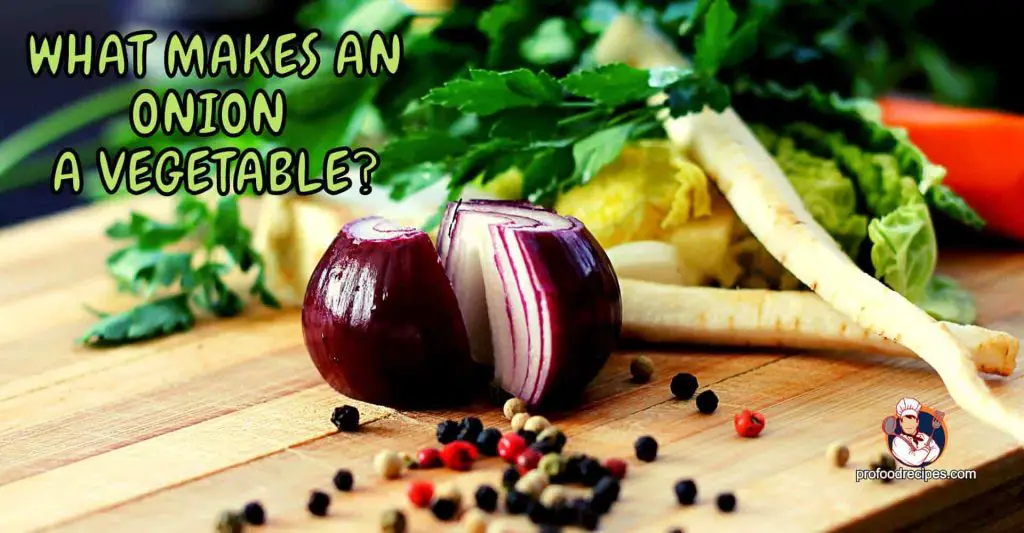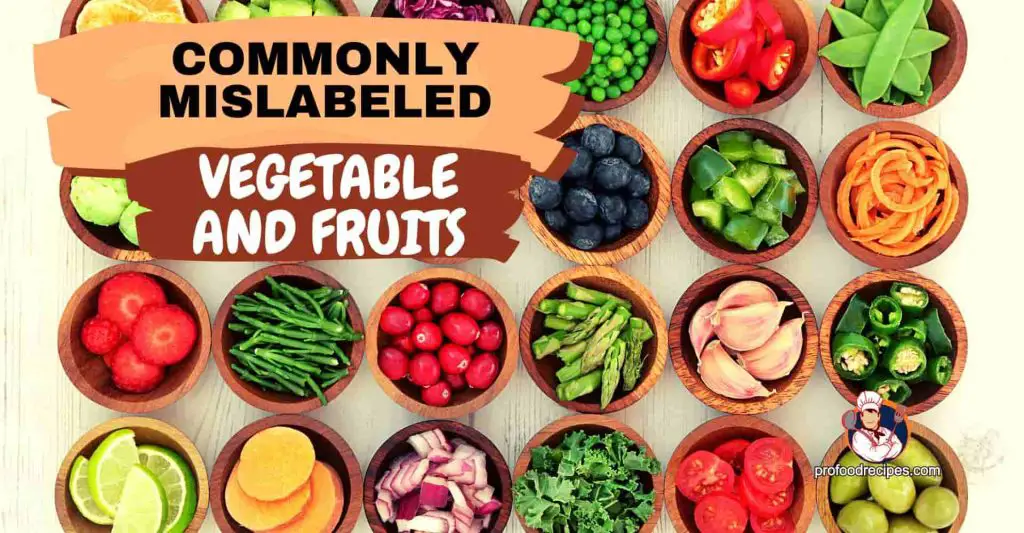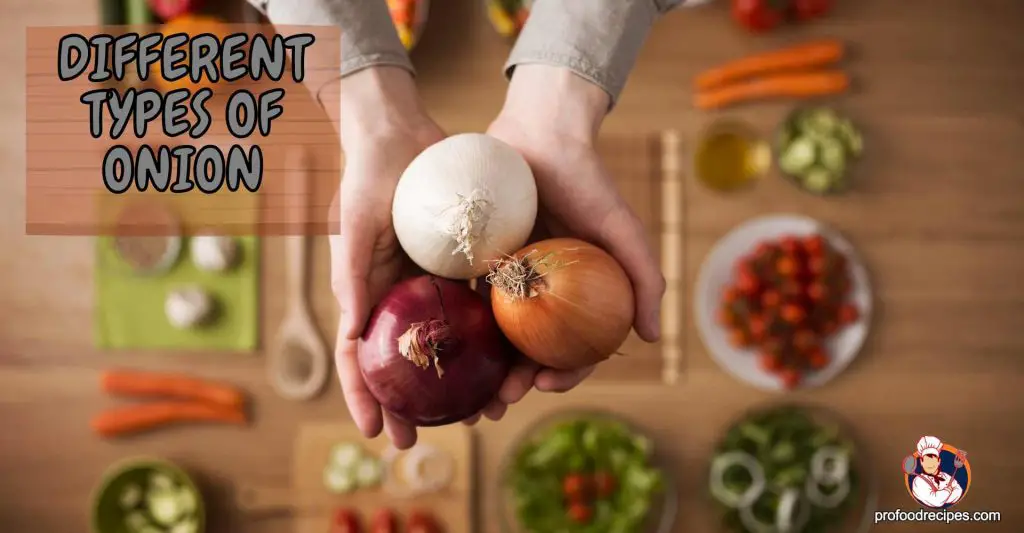Last Updated on January 31, 2023 by Amanda P. Brown
The onion is the most extensively grown Allium species. The onion is classified as a vegetable since it lacks seeds yet has edible elements, most notably the bulb.
Onions come in many colors and sizes, from red to yellow to brown to miniature. Thought to be native to southwest Asia, they are now grown throughout the world. Onions are commonly used vegetables as taste enhancers because of their versatility. To provide an aromatic basis for soups, stocks, and sauces, they are often sautéed with carrots and celery to form mirepoix.
Despite onions’ seeming pervasiveness in Western diets, their classification sometimes creates confusion. If you’ve also ever wondered, “Is Onion a Vegetable or not?” Or what should onions be classified as? You can get information from the article that follows.
Is Onion a Vegetable or a Spice?
Table of Contents
The onion is both a vegetable and a vegetable bulb that you can eat. It is a regular ingredient used as a spice to enhance the flavor of food. Due to its qualities, it is used with almost a variety of meat and vegetable dishes.
In pickles and sauces, you can also digest onions with various vegetables, such as lentils and beans. Besides, you can eat it raw because of its antioxidants, which benefit our bodies.
What is a Fruit?
A fruit is defined as “the mature ovary of a blooming plant that is consumable,” according to the scientific definition. The fruit is the part of the ovary that contains the seeds. The fruit grows from the plant’s flower, and its function is to disperse the seeds and help produce new fruit. Often, there are many we know as vegetables, such as cucumbers, peppers, and tomatoes, but they are usually classified as fruits.
What is a Vegetable?
You can cultivate a vegetable’s appetizing section either above or below ground. It can consist of stems, roots, bulbs, and leaves. It is an integral part of the vegetable plant that can be eaten and typically contains no seeds.
What is the Difference Between a Fruit and a Vegetable?
Fruits are those that grow on trees and are sweet, and vegetables are those that are not sweet.
Fruits and vegetables are divided into various categories based on their botanical origin. A plant’s flower only produces fruit; the rest of the plant is categorized as a vegetable. Vegetables are not limited to only roots and stems but can also have leaves, whereas fruits have seeds.
What Makes an Onion a Vegetable?

Fruits and vegetables are harvested from edible plant parts but come from different plant kingdoms. Onion plants usually grow above ground and do not contain seeds like fruits. And it does not come from the portion of the plant that yields flowers. As a result, they’re considered a vegetable.
Whole vegetables and fruits come from seeds, but onions do not have seeds that grow asexually to imitate new onions from their bulbs. Onions supply their nutrients inside the bulb, and these stored nutrients are sufficient to permit their reproduction.
Read More: Is Egg a Fruit or Vegetable?
What Makes a Vegetable a Vegetable?
A vegetable is a vegetable because it doesn’t have seeds, unlike a fruit. A vegetable is a part of a plant that is palatable, like roots (parsnips), leaves (lettuce), tubers (potatoes), stalks (celery), flowers (broccoli), or bulbs (onions).
Are Onions Root Vegetables?
Yes, onions are present in many vegetables, including parsnips, carrots, chives, and root vegetables. Various vegetables are known as root vegetables, with their developing point under the ground. But possibly, you can also eat the stems of the onion plant and the bulb.
Why Do People Mistake Onions for Fruits?
Some people have the misconception that they consider an onion a fruit. They think that onions are manufactured from bulbs and can imitate themselves like fruits. But they forget that onion bulbs do not contain any seeds and are not manufactured from the plant’s flowers, like fruits.
Is Onion a Fruit?
Onions are not fruits. The bloom and the seed of this plant are inedible since they do not generate any edible portion. This is why onion is not a fruit.
Commonly Mislabeled Vegetables and Fruits

Scientifically, many studies have shown that there are some mislabeled vegetables and fruits, that many people do not know exactly which ones are fruits and vegetables. Here are a few suggestions:
- Cucumbers: Since a cucumber has seeds and develops from a flower, it recognizes as a fruit.
- Avocado: Avocados are fruits and are a type of berry with a secluded seed.
- Tomatoes: Tomatoes contain seeds and are derived from flowers which are considered a fruit.
- Rhubarb: Rhubarb is considered a vegetable because the stalk is edible.
- Green Beans: Green beans are classified as a fruit because they contain seeds.
- Corn: Corn belongs to grain, fruit, and vegetables. But botanically speaking, corn is a fruit because it arises from the ovary and flower of the corn plant.
Onions of Origin
Around 5000 years ago, onions were first cultivated in Asia or the Middle East. It stands for one of the ancient food sources. It was essential to the diet of many premature cultures and was in high demand in ancient Egypt. Later European colonizers brought onions to America scarcely to search for onion plants that were previously readily accessible.
Where Are Onion Seeds Produced?
Onion seeds are typically grown from the flowers of the onion plant. Onion plants bloom once every two years, and the flowers yield seeds. Besides, onions are capable of being produced from bulbs without their roots.
Is It Simple to Grow Onions?
Growing onions is a fairly simple process. They are typically started planting in the early spring and harvested in the mid to late summer. Onions do not require a lot of space to develop, and you can grow them well in containers, grow bags, or any place with good soil quality.
But for onions to grow well, you need to fulfill the various basic needs of the plant, such as good soil and water, and ensure that they get enough sunlight. You can use this onion in multiple ways, making pickles while serving salads as a garnish, and it can be eaten raw as a vegetable. If you sell it as a business, you can also profit from doing so.
Besides, by producing this onion, you will save yourself from the bargain price of your market, and you will not need money to buy it.
Is a Garden Necessary to Grow Onions?
A garden is not necessary to grow onions. Onions can be grown anywhere you like, in your rooftop tub, in containers, in your neighborhood yard, or even indoors.
To grow well, you must ensure that good soil is used, gets enough sun, and is watered as much as it needs.
What Are Onions’ Health Advantages?
Consuming onions is good for our health. Onion is a nutrient-rich vegetable with minerals and vitamins such as vitamin B6, potassium, folate, manganese, and vitamin C. Therefore, onions are complete with antioxidants, which are good for our heart, help digestion, bone density, blood sugar control, and even campaign against cancer.
Types of Onions

In today’s world, onions come in wide varieties. Some names of onions are mentioned below:
- Yellow Onion.
- Red Onion.
- White Onion.
- Vidalia Onion.
- Shallot.
- Spanish Onion.
- Maui Onion.
- Egyptian Onion.
- Torpedo Onion.
- Bermuda Onion.
- Walla Walla Onion.
- Green Onions.
- Cipollini Onion.
- Chives.
- Leeks.
Here Are Some of the Onions Discussed in Detail
Archaeology of Fruits and Vegetables – Red Onion
Red onion is a species that can be cultivated and is also rich in culinary uses. It brings flavor to the food and also adds a nice color dimension to the food. However, to know better about red onion, you must first understand what red onion is.
What is a Red Onion?
Red onions are purple or reddish, but when cut, the inside is white, and the skin is colored throughout. These onions are usually medium to large. And this onion has a strong smell when eaten raw.
Why Are Red Onions Beneficial?
Red onions, out of all onions, have the most health advantages. These onions are high in antioxidants such as anthocyanin and quercetin. Apart from adding a distinct flavor to food, this onion is believed to help destroy cancer cells in the human body.
When Are Red Onions in Season?
Red onions are best planted in summer or spring in more relaxed environments or winterized in warmer climates. It is typically harvested in late summer or early fall, depending on the growing environment.
How Should Onions Be Stored Properly?
Onions are very easy to store. If you want to store onions for a few days, you can store them in a container in a dry place and keep them in a bag with a hole in it because the onions will be better if there is good air circulation inside.
Also, if you plan to store the onions in the fridge, I don’t think it’s a good idea because the environment inside the refrigerator is moist and cold, which can cause the onions to soften and spoil.
However, keep onions in a cool, dry, well-ventilated area and the dark for the best storage results.
Archaeology of Fruits and Vegetables – Yellow Onion
One of the most commonly used onions in cooking is yellow onion. You can easily find these onions in any super shop, grocery store, and market.
What is a Yellow Onion?
The skin layers and flesh of yellow onions are usually yellow or brown or pale golden. Like red onions, it is a strong onion, but with higher sulfur content, it adds a more complex flavor to cooking. Besides, you will find these onions easy to cook.
Are Yellow Onions Healthy?
Of course, yellow onions are excellent for cooking. Most yellow onions and red onions are more beneficial than all other onions.
When eaten raw, the antioxidants present in this onion help avoid illness and disease in our bodies. In addition, it can decrease antioxidant levels in cooking.
When are Yellow Onions in Season?
In cooler growing seasons, yellow onions can be cultivated from late spring through early summer. They are collected between the end of summer and the start of autumn. Onions are developed in the winter and collected in the spring during the warm growing season.
How Should Yellow Onions Be Stored?
The perfect environment for yellow onions is calm, dark, and dry. Because onions can get moldy if held in moist areas, you can also store onions for a long time by keeping them in an airtight bag, bowl, or container.
Is It Possible to Cut an Onion Without Crying?
In almost all kitchens, onions are used extensively in various dishes. So while cutting an onion, water often comes out of our eyes. So, the methods for cutting an onion without crying are listed below:
- To begin, choose a sharp knife. Because if the knife is sharp, you will cut the onion faster, and the chances of crying will decrease. And if the knife is dull, it will take time to slice the onion, and the sulfur in it will come out, irritating our eyes.
- Freezing the onion for 10 to 15 minutes before slicing it is an additional straightforward technique. A blast of cold inhibits the release of tear-forming enzymes in the air. Then slice the onions quickly after taking them out of the freezer because the enzymes inside the onions will become more active as they heat up, and your eyes will start to irritate.
- Another simple trick is to soak onions in cold water for a while so that the compound in the onion doesn’t come in contact with the air, so it won’t irritate your eyes while cutting.
- Finally, there is a good strategy you can use for kitchen goggles while cutting onions, as this will protect your eyes from the tear-inducing compound in the onion.
How Are Yellow, White, and Red Onions Distinct?

The flavor, nutrition, and appearance of red, white, and yellow onions differ. Many recipes refer to specific onions for their variations. However, they can take the place of each other as they will perform the same in the cooking pot. You can distinguish red, white, and yellow onions from one another in the following ways:
Red Onions
These onions are spicy and colorful but light in taste. Its outer skin and flesh are purple or reddish. These onions are commonly used in salsas, salads, and other renewed recipes for their color and light flavor. Their red color washes off when cooked.
Also, if you observe their smell acrid when eaten raw, drench them in water for some time before dishing up.
Yellow Onions
The yellow onion is thought to be the best onion. Yellow onions have an equilibrium of flavor and sweetness because the lengthier they are cooked, the sweeter they become. This onion is the best-selling onion in America and is versatile enough for anything. Also, yellow onions are good enough to caramelize.
White Onions
White onions have a more sharp taste than yellow onions. Its skin is slender and tender and cooked similarly to a yellow onion. It is used in salads, minced meat, raw salsas, and chutneys.
Read More: Different Types of Bowl Shapes and Their Uses
FAQs
What Plants Are Called Bulbs?
Several plants have bulbs inside, such as daffodils, alliums, tulips, and hyacinths. Onions are members of the allium family and, like other bulbs, can produce new bulbs from subterranean root bulbs.
What Distinguishes an Onion From Steam?
An onion’s ultimate nature is a bulb, not a stem. Though, the bulb has swelled eatable leaves. It is not stalks and leaves because they have a smooth base with no lumps.
Is Onion a Root?
No, onions are not considered a root. Due to their underground growth pattern, onions sometimes become tangled in their roots. You may also consider the structure’s stem-like origins in terms of a bulb and stem.
Is Onion a Berry?
A berry is a fruit that is round, small, and juicy. An onion is a vegetable with no seeds and does not originate from the flower of a plant. Onion falls under the category of vegetables because it is not a berry.
Is an Onion a Bulb?
An onion is, in fact, a type of bulb. Onion bulbs are adapted stems because fleshy, fibrous leaves are abundant. Onions look like tunic bulbs due to having fleshy fibrous leaves. At the bottom of the onion, the structure can be seen as a root thread.
Final Verdict
Onions have many qualities in terms of taste that enhance food taste. Onion, like its close relative garlic, has many beneficial properties in treating earaches, colds, animal bites, warts, and laryngitis. However, I hope the above article is about Is Onion a Vegetable? It was helpful to know all onion-related information.
You May Also Like to Read:
- Different Types of Dinnerware and Their Uses with Picture
- Wok VS Frying Pan – Which One to Use?
- Gluten Free Chinese Food Recipes
- Home Tips for Weight Loss
- What Does Pineapple and Cranberry Juice Do for a Woman?

